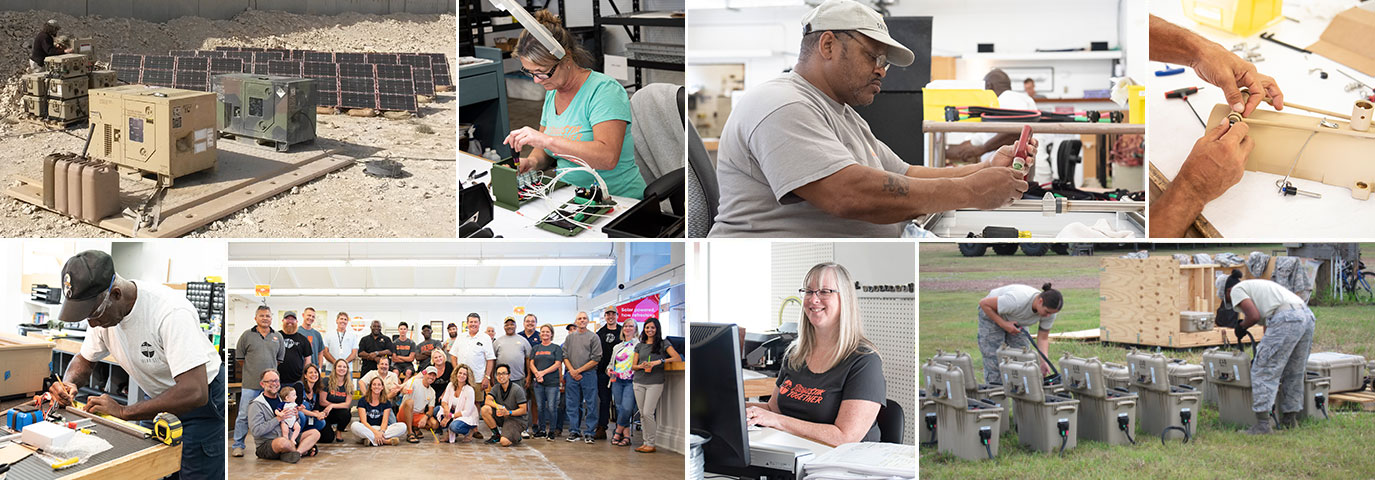
There’s a milestone or breakthrough nearly everyday at Solar Stik. Whether our Engineering Team designs a new product, our Production Team gets a huge order out the door, or we welcome a new addition to the Team, it’s moments like these that make Solar Stik the company it is. Below are just a few excerpts from the chapters of Our Story.
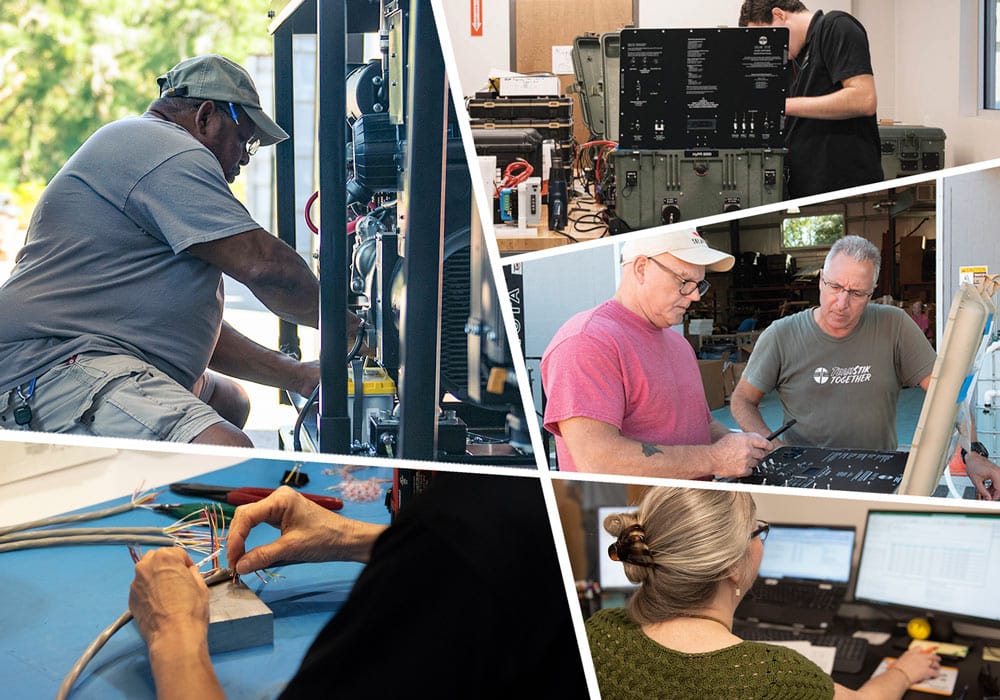
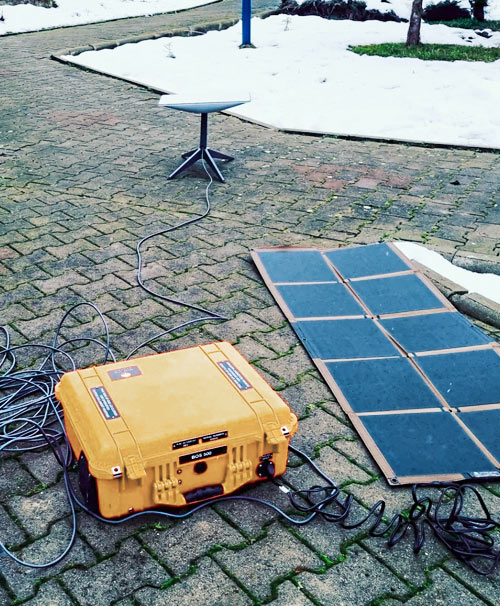
In response to the tragic events unfolding in Ukraine, our team quickly provided assistance by working with Noble Supply & Logistics to supply 300 portable power systems to the Ukrainian military. These systems were designed to withstand harsh environments, from Antarctica to Afghanistan, and provide reliable power to the people of Ukraine.

After almost 20 years of service at Solar Stik, Stephanie Hollis, M.D. is appointed President and CEO. One of Solar Stik’s original founding members and an anesthesiologist by trade, her extensive medical experience matches her operational business experience designing, building, deploying, and supporting rugged power systems across the globe. With Dr. Hollis at the helm, Solar Stik is poised to take advantage of these greater opportunities, including new markets, partnerships, and products.
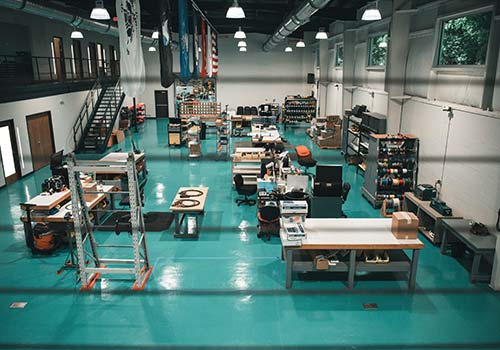

In the midst of the COVID-19 pandemic, demand for Solar Stik®, Inc. products continues to grow. In order to meet this demand, Solar Stik expands its workforce by over 35%, hiring professionals from the local St. Augustine community and across the nation. Recent history reflects similar mission success and owner commitment, with 25% annual growth from 2016 to 2020.
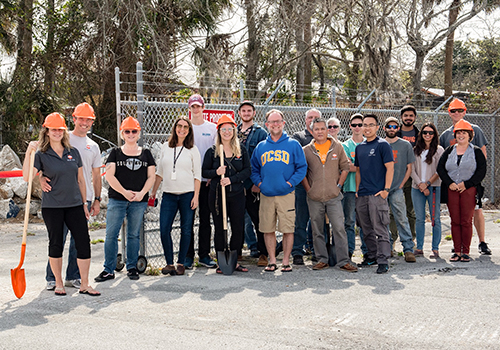
Solar Stik’s new state-of-the-art facilities are underway with estimated completion in 2020! For the first time in many years, all departments will be co-located on one property, from administration to R&D, manufacturing, and sales. The new House of Stik will further allow the Team to serve customers across the globe with our flagship hybrid power technologies. Solar Stik is proud to continue adding to its presence in the West King Street district of St. Augustine, Florida, with new construction thoughtfully led by Solar Stik C.O.O. Stephanie Hollis of Design M.D.

Solar Stik®, Inc. is honored in the Florida Companies to Watch ceremony as one of fifty statewide companies expected to see significant growth over the next several years. Solar Stik was selected from more than 500 nominees for Florida Companies to Watch, a statewide program managed by economic development group GrowFL and the Edward Lowe Foundation.
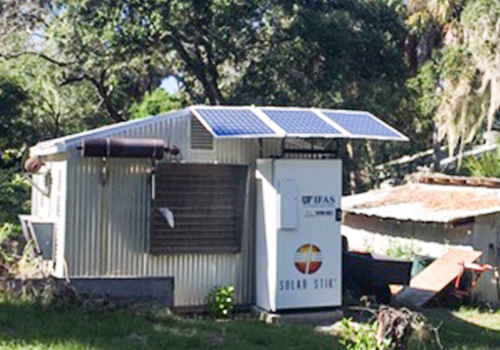
The University of Florida Institute of Food and Agricultural Sciences (UF/IFAS) Nature Coast Biological Station employs a Solar Stik®, Inc. LifeGuard Battery Cabinet to reduce generator runtime and fuel consumption at its (or the) facility in Seahorse Key, Florida. The cabinet allows the island to operate in a high-efficiency circuit that stores or consumes all generated power and, on an annual basis, will save Seahorse Key 30% of propane use, one 400-gallon fuel run, between $1,000 and $2,500 in fuel and maintenance costs, and hours in logistical complications.

Solar Stik®, Inc. opens its state-of-the-art Research & Development facility, adding substantial presence to Solar Stik’s campus in the West King Street district of St. Augustine, Florida. The new center serves as an incubation hub for the development, refinement, and integration of hybrid power technologies. The Solar Stik Engineering Team, which has grown to include alumni from Northrop Grumman and U.S. Army Field Service Representatives, uses this new facility to refine leading-edge technologies into mature, sustainable platforms that keep Solar Stik’s flagship high-efficiency power systems at the forefront of the portable power industry.

Solar Stik®, Inc. hosted Florida Governor Rick Scott for the announcement of the state’s lowest unemployment rate in more than 10 years. Governor Scott attributed the creation of 26,300 private-sector jobs in July to the 3.7 percent unemployment rate. During his visit, Governor Scott also presented Brian Bosley, Solar Stik CEO and co-founder, with the Governor’s Ambassador of Business Award at the morning press conference. The medal is given to individuals for their efforts in creating jobs and opportunities for Florida families.

Solar Stik®, Inc. shipped its 100th Hybrid Power System (HPS) 7000 in mid-August. The HPS 7000 reduces the fossil fuel consumption of fuel-driven generators used by many military applications by sourcing stored energy from a battery bank and prioritizing renewable power generation sources—solar and wind—to maximize the operational efficiency of power circuits. Solar Stik received its first order for the HPS 7000 in June 2014. The U.S. Army initially ordered 50 systems to support the reset of the Rapid Aerostat Initial Deployment (RAID) surveillance tower system. The HPS 7000 was selected as the Alternative Energy System (AES) enhancement for the Persistent Surveillance Systems-Ground (PSS-G) Heavy over competing power systems, and the U.S. Army has since made the AES officially part of the baseline for the PSS-G Heavy.
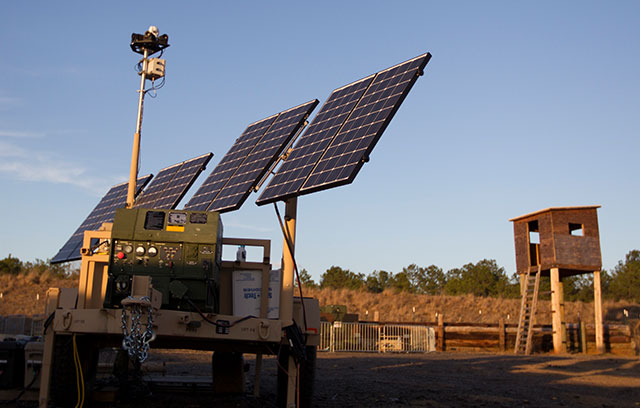
Solar Stik, Inc. acquired all tangible capital assets held by EMX International, LLC / SMCI, LLC in a deal that includes the manufacturing equipment used for EMX’s production of mobile hybrid power platforms, thermal imaging camera systems, and thermal weapon sight products. Our Engineering and Production Teams will gain a complete machine shop suite with a 5 axis CNC, vertical milling machine, and an industrial 3D printer. This precision tooling and engineering equipment will be brought online immediately at our St. Augustine, Florida, manufacturing headquarters. Other acquired infrastructure will be put into service following the build out of our new engineering facility scheduled for late 2018.

On April 6, 2018 our production Team celebrated 1000 days without an accident! That’s more than two and a half years without an incident resulting in a loss of productivity or time away from work. Our production Team is the backbone of the Solar Stik family. Note: The mystery broken foot (right) and missing finger (center) pictured were nonwork-related incidents!

The original STIKopedia debuted more than 10 years ago as a PDF. Since then, technologies in both the portable hybrid power industry and how we access information changed. The web-based, updated version of STIKopedia is an interactive learning tool designed for anyone to jump in anywhere—from learning the basics of electricity to understanding portable hybrid power systems.

Solar Stik, Inc. is ranked #73 for the University of Florida’s 2016 Gator100, which ranks the 100 fastest-growing, Gator-owned or Gator-led businesses each year. The award recognizes and celebrates the achievements of leading UF alumni entrepreneurs around the world, regardless of their field of study. Stephanie D. Hollis, MD, Chief Operating Officer and cofounder of Solar Stik, is a 2000 graduate of UF’s College of Medicine and a 2004 graduate of their residency training program in Anesthesiology at Shands at UF. She is also a practicing anesthesiologist.

Solar Stik enters into a multi-phase, cooperative venture with fuel cell manufacturer SFC Energy. Phase one of the venture provides SFC with logistics, service, and inventory support for SFC Energy’s North American customers. Both Solar Stik and SFC have complementary capabilities and service similar customers in the hybrid portable power marketplace.

The Solar Stik Team grows to 30 members, and the company celebrates 10 years in the Portable Power industry.
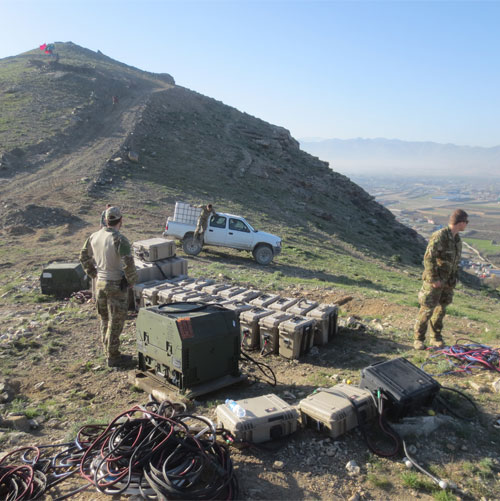
Solar Stik makes a foreign military sale to the Afghan National Army (ANA) and improves the intuitive design of the Inter-Connect system by incorporating color coding for quick identification of connections in the circuit.
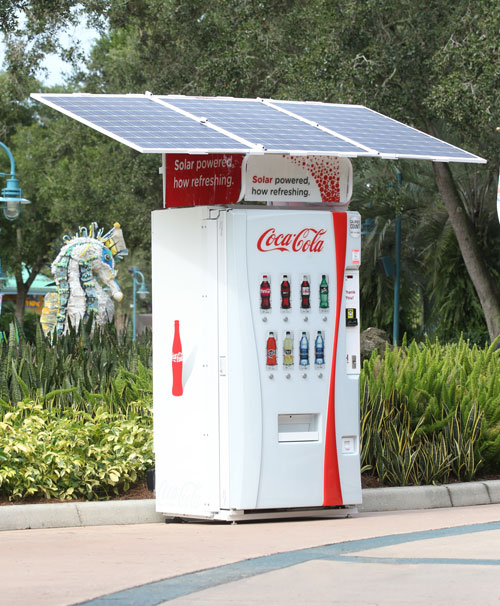
Disney’s ESPN Wide World of Sports Complex deploys two Renewable Equipped Vending (REV) Machines following a successful initial deployment of six prototype REVs at SeaWorld in Orlando, Florida. The solar-powered machines are selling beverages at the following locations within Sea World: Shamu’s Happy Harbor, Key West; Terrace Garden, Pacific Point Preserve; and Aquatica, SeaWorld’s Waterpark.
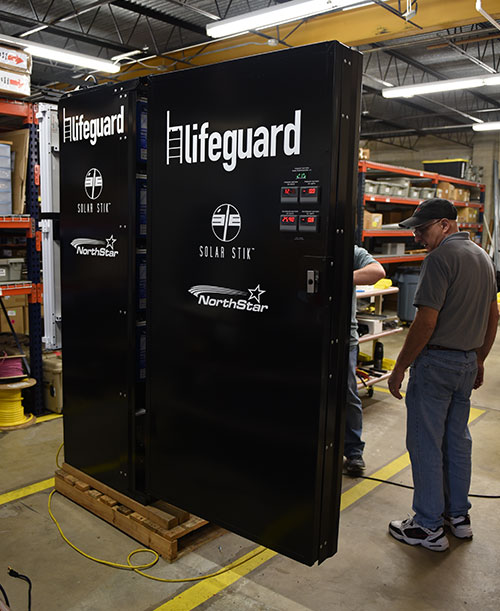
Development begins on the LifeGuard Battery Cabinet. The LifeGuard is a climate-controlled, backup power supply.
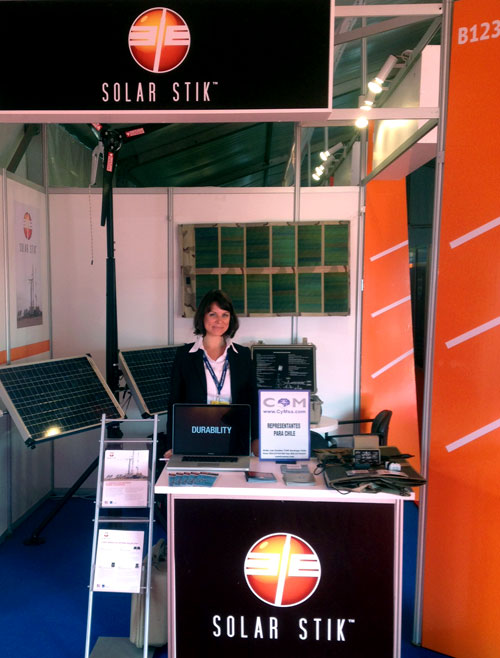
Solar Stik attends its first international trade show, FIDAE 2014 (International Exposition of Air and Space). The show is located in Santiago, Chile, and is Solar Stik’s introduction to several new international business partnerships.

The 226 campus is open for business! This building—the oldest building in the 200 block of historic West King Street in Saint Augustine—is the completely renovated and restored home of Solar Stik’s headquarters.
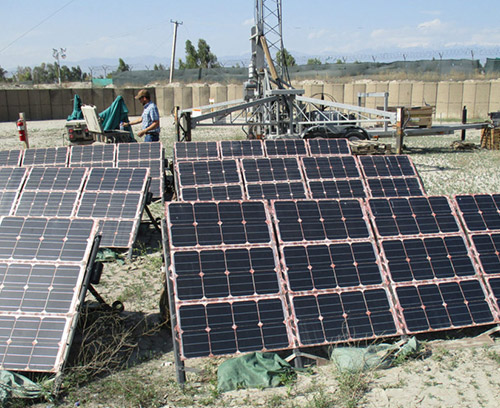
Solar Stik’s Alternate Energy System (AES) is selected by the U.S. Army’s Product Manager Electro-Optic/Infrared–Force Protection (PM EO/IR–FP) to power the Persistent Surveillance System–Ground (PSS-G) and Rapid Aerostat Initial Deployment (RAID) programs. The original configurations for the PSS-G and RAID platforms included only a Tactical Quiet Generator (TQG) as the primary power source when used for “independent” operation. The Solar Stik PSS-G AES is designed to seamlessly interrupt the existing power circuit and create a hybrid model that includes the use of the traditional TQG, but it focuses on the power generated by renewables (solar power) as the primary means of daily power generation. This is accomplished through the introduction of a high-efficiency battery circuit. Also in 2014, a Solar Stik Power Solution is adopted by the U.S. Army’s Counter-Rocket, Artillery, Mortar (C-RAM) program as the “program of record” power solution for the WARN tower.
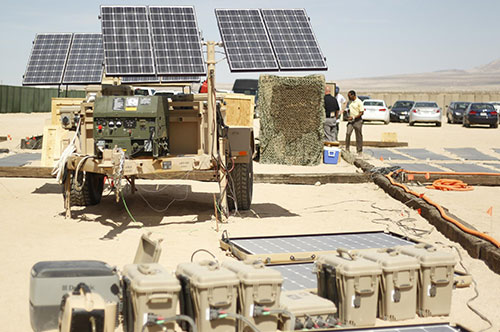
Solar Stik Hybrid Systems undergo further testing by the Marine Corps Expeditionary Energy Office during the Experimental Forward Operating Base (ExFOB) demonstration. Utilization of Solar Stik Hybrid Systems is expanded in theater.

Brian Bosley and Stephanie Hollis complete Dave Ramsey’s Entreleadership Training and reshape the way Solar Stik is run as a company. The Mission is clearly defined and Leadership refocuses on the company’s original core values: Teamwork, Compassion, Integrity, Quality, and American Made to strengthen the culture at Solar Stik, Inc.

The U.S. Army’s Rapid Equipping Force (REF) deploys Solar Stik Systems for field testing for the following applications: command, control, communications, computers, intelligence, surveillance and reconnaissance (C4ISR), force protection, field medical, emergency response, archaeology, and more.
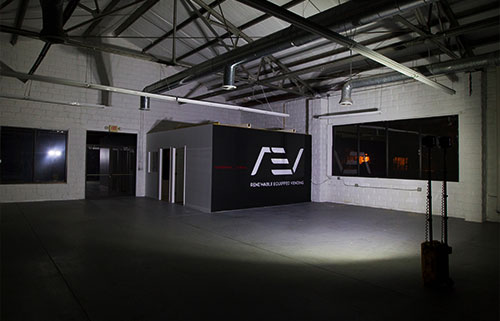
Solar Stik begins development of the Renewable Equipped Vending (REV) Machine for Coca-Cola. The original Coca-Cola bottling plant in Saint Augustine is converted into a prototyping facility for the development of the machines. The prototypes are unveiled in June.

The Team gets new quarters…following some major renovations. Solar Stik moves its production facility to 195 W. King Street, and its engineering and executive teams move into 226.5 W. King Street (a.k.a. The White House).
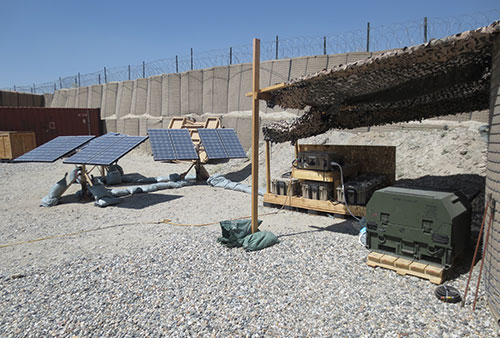
Solar Stik’s 3kW TQG Hybrid System is deployed by the U.S. Army’s Rapid Equipping Force (REF).
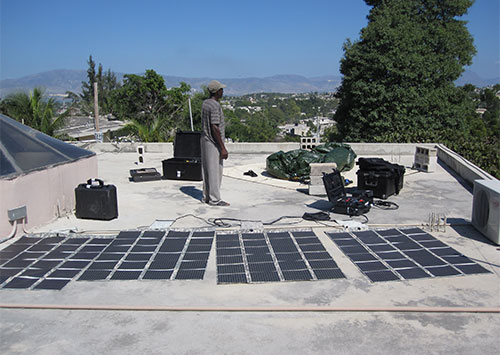
Dozens of Solar Stik Systems are sent to Haiti to provide power following the 2010 earthquake.
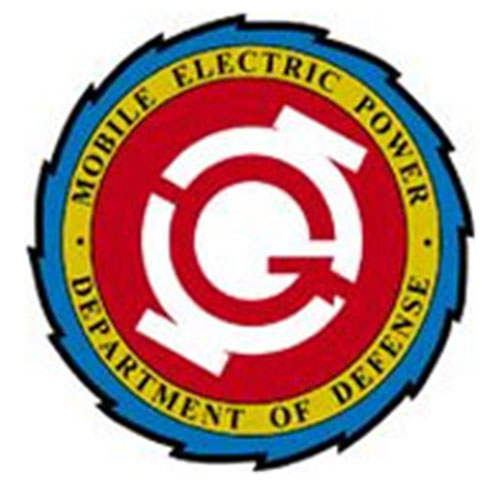
Solar Stik enters into an agreement with the United States Army Research, Development, and Engineering Command, Communications-Electronics Research, Development and Engineering Center (CERDEC) to engineer a “hybrid” power solution that enables a conventional U.S. Army TQG to operate seamlessly and automatically with a battery-based alternative energy system. The objective is to reduce fuel consumption, which in turn reduces the burden of fuel delivery to remote locations, and ultimately saves the lives of soldiers going outside the wire.

Second cross-country road tour! Solar Stik makes stops in 15 states en route to California and back.

Despite three weeks of rain, Solar Stik maintains operations using its hybrid power model at the Army Program Manager Mobile Electric Power (PM MEP) “GREEN COMMAND POST” Joint Users’ Interoperability Communication Exercise (JUICE). This garnered interest from the U.S. Department of Defense in Solar Stik’s Hybrid Power Systems.
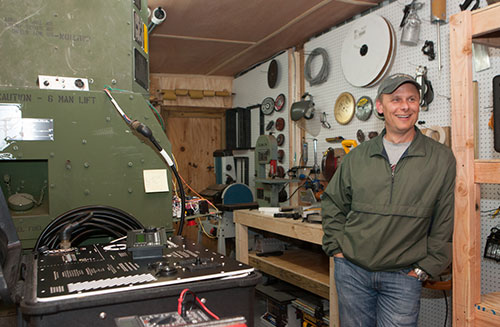
Glen Flitter Joins the Team. Strategic partnerships with domestic manufacturers evolve. A commitment is made to exclusively use American-made components in the Solar Stik System.
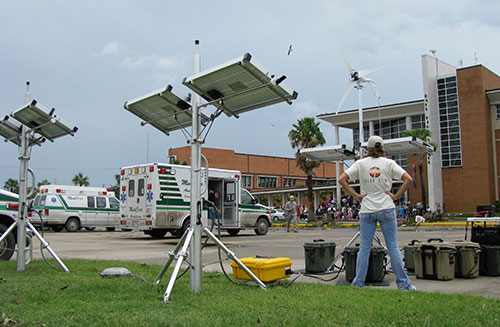
Founders Brian Bosley and Stephanie Hollis travel to Galveston, Texas, to provide power to first responders during Hurricane Ike. Solar Stik Systems power emergency communication equipment and other devices critical to maintaining morale and comfort (a.k.a. coffeemakers!).
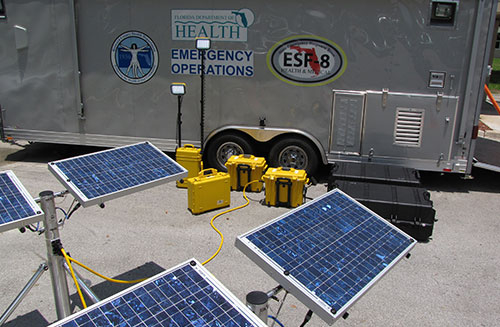
The State of Florida Emergency Operations Command adopts Solar Stik hybrid power platforms to operate all of the state communication trailers used during disaster or emergency deployments.

In response to a priority-one directive issued by USMC Maj. Gen. Richard Zilmer, the United States Army’s Power Surety Task Force acquires Solar Stik equipment for deployment into the Iraqi theater of operation.
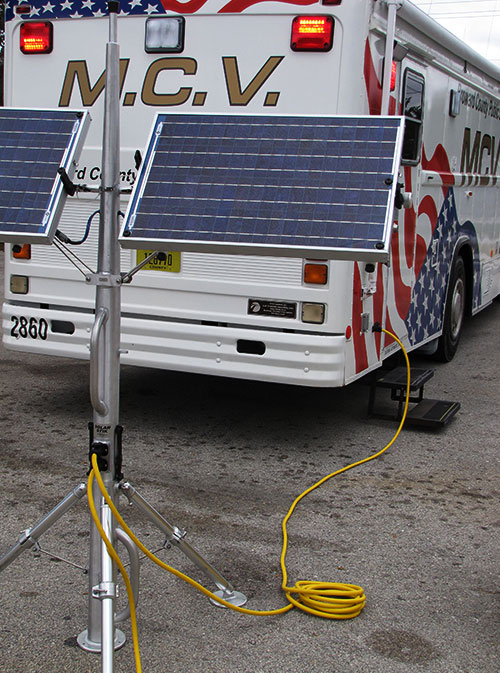
County-level Emergency Operations Centers in the State of Florida begin to adopt Solar Stik as part of their disaster-response equipment.
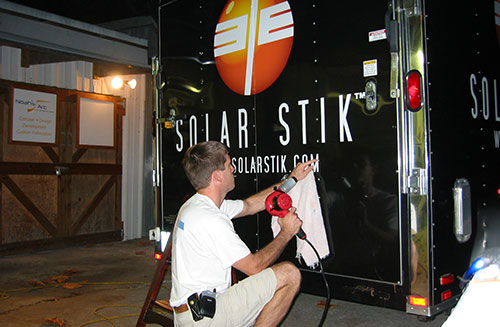
Inaugural cross-country road trip to demonstrate the Marine Solar Stik to the cruising community on the West Coast.
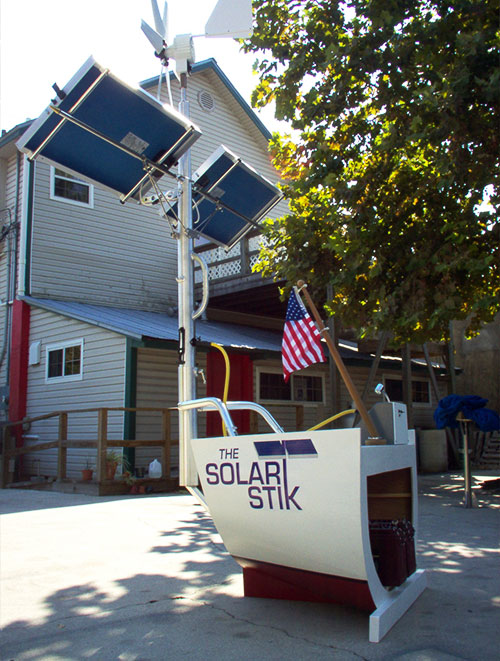
Solar Stik tackles the sailboat community, and continues developing the land-based version for terrestrial operators.
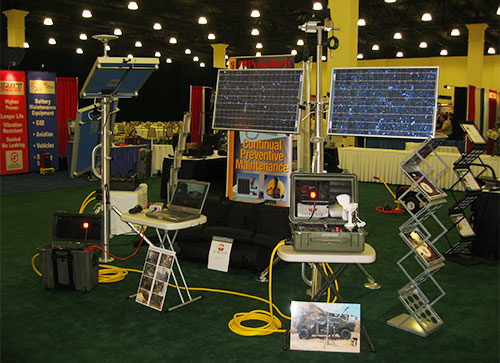
First military trade show! Solar Stik demonstrates its land-based adaptation of the system at Modern Day Marine in Quantico, Virginia.
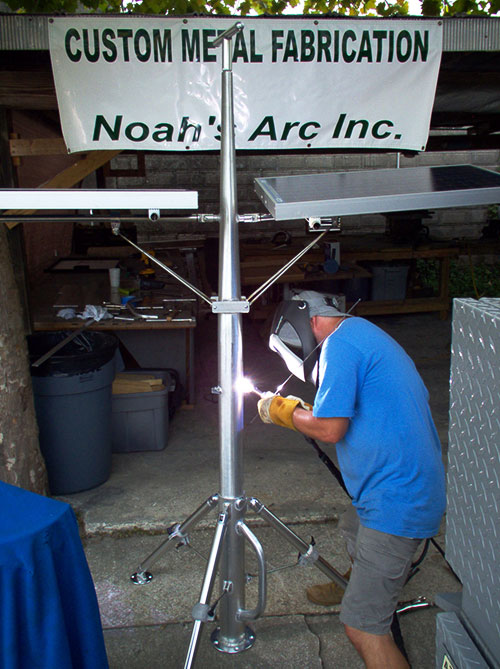
Solar Stik makes its debut as a company offering the only portable power generator of its kind in the world. The design, research and development, testing, and production all were conducted in a single room…by five team members, two of whom are its founders.

The Solar Stik® is first envisioned aboard small sailboats in Key West, Florida, during the winter of 1997–98. Faced with the need to generate power for refrigeration, communication equipment, and lighting, but challenged by lack of space aboard, the original Solar Stik design is a lightweight, freestanding solar and wind turbine power generation platform mounted to the boat’s transom or deck. Based on that design, three original Solar Stiks were assembled and put into use. Each one logged thousands of miles at sea and produced reliable power aboard in remote anchorages. The self-sufficiency provided by the Marine Solar Stik led one of its creators, Brian Bosley, to adapt the design for use on land, opening a new venue for the product.
Battery Voltage
Battery voltage, or state of charge (SOC), of a lead-acid battery can be estimated by measuring the open (no load) battery terminal voltage using a digital voltmeter. Prior to measuring, the battery must have rested for 4 to 8 hours after charge or discharge and resided at a steady room temperature. With these conditions met, voltage measurements provide an amazingly accurate SOC for lead-acid batteries.
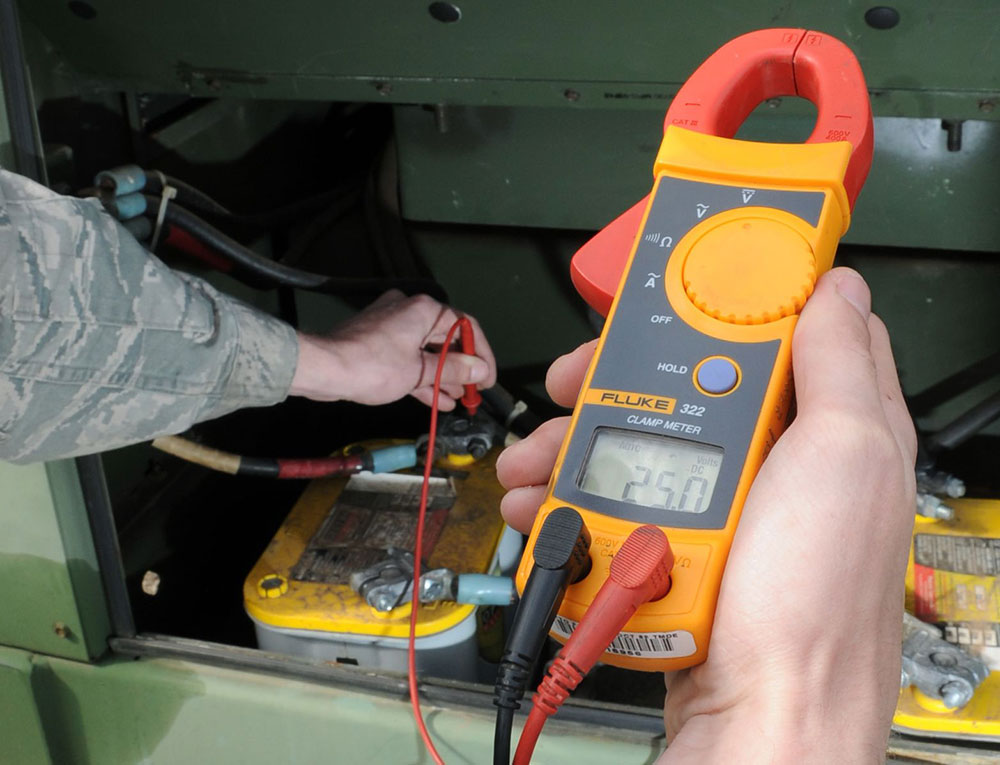
Specific Gravity
Specific gravity can be measured in wet-cell batteries with removable caps that provide access to the electrolyte. To measure specific gravity, you must use a tool called a temperature-compensating hydrometer, which can normally be purchased at an auto parts store or tool supply.
Load Testing
Load testing removes and measures the amps from a battery, similar to what happens when you start the engine of a car. Some battery companies label their battery with the amp load for testing. This number is usually about half of the CCA rating. A battery rated at 500 CCA would therefore be load-tested at 250 amps for 15 seconds.
A load test can only be performed if the battery is at or near a full charge. Some electronic load testers apply a 100-amp load for 10 seconds, and then display battery voltage. This number is then compared to a chart on the tester, which compares common load testing results to CCA ratings to determine battery condition.
Solar Stik uses only lithium iron phosphate (LiFePO4) battery chemistry in its lithium-ion energy storage products because it has safety characteristics similar to lead-acid batteries. LiFePO4 uses a nonflammable electrolyte, so when it’s completely discharged it becomes inert, making it safe for users.
In some lithium-ion polymer batteries, improper charging and storing can cause the formation of crystalline “needles” that can puncture the internal separator, resulting in failure or fire. This is not the case with LiFePO4 batteries because the reactants that store the charge are not flammable. All other lithium battery chemistries are volatile, reactive, and flammable, and if they do overheat and catch fire, conventional halon fire extinguishers will not put out the fire.
Common LiFePO4 cell types include cylindrical and prismatic (LiFePO4 chemistry is not packaged in pouch cells, another lithium cell type). It is easy to see how these were named, as they are actual descriptions of their physical attributes; they look like what they sound like.

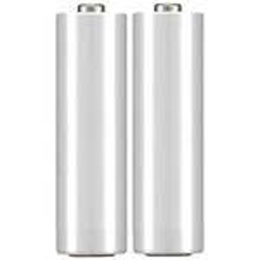
Cylindrical
LiFePO4 cylindrical cells are all made of the same basic components. Each cell, and the entire battery, is enclosed by a resilient plastic container. Inside the container there is a “rolled” foil, and between the foil there is a layer of permeable “separator” material. A safe, nonflammable electrolyte (unique to LiFePO4) is added to each cell and saturates the “foil” and “separator”. The battery terminals are typically threaded (rather than posts) so that heavier-duty connections can be made to the load.
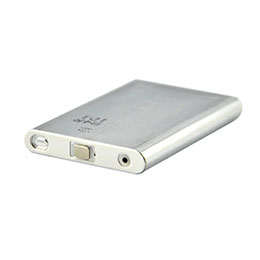 Prismatic
Prismatic
LiFePO4 prismatic cells make optimal use of space by using the layered approach. Small, flat versions are used in mobile devices where space is at a premium. The terminals can be oriented in any direction, which is an important feature for handheld devices. The smaller formats often have a softer, more flexible exterior and are sometimes referred to as pseudo-prismatic jellies.
Larger versions of the prismatic format are used to power vehicles and are often housed in welded aluminum housings. Stronger exterior housings are often required to compensate for the structurally softer inner construction of the prismatic format. Less efficient thermal management is inherent in their design, and overheating can reduce the life cycle and cause the cells to swell. If this occurs, remove and replace the battery before there is any damage to the component using the battery.
LiFePO4 is slightly less powerful than other commercially available lithium chemistries, but for many applications, the safety of its chemistry makes it the best choice despite its lower energy density. A LiFePO4 battery can be installed safely in any orientation. Safety vent valves are usually not required because the battery management system (BMS) will not allow the battery to overheat and vent gasses.
History of Lithium-ion Batteries
Experimental lithium batteries were developed as early as 1912, but it took nearly 70 years before a commercial lithium battery was developed for a wide market. Today, lithium batteries are most associated with enhancing “portable” capabilities. For example, they are the standard battery technology for high performance in portable electronics ranging from cell phones to laptop computers. There is a diverse family of lithium chemistries available. At first glance, they might all seem to be the same, but there are exploitable, distinct differences between them. The unique nature of the various chemistries allows each type to fill special application niches.
Even with wide market adoption in the early 1990s, as societal demands for lightweight portable electronics was burgeoning, the high cost barrier and complexities in battery management circuits would prevent lithium batteries from being used widely in support of larger devices or in scaled energy-storage systems such as large vehicles or uninterruptible power supply (UPS) systems.
Today, lithium battery technology continues to evolve at a rapid pace. Manufacturers, driven by demands from new applications, are constantly pushing the envelope by making changes in the chemistry and structure in search of improved battery life and greater energy density.
Lead-acid batteries are the most commonly used batteries and come in several different configurations. The oldest of the lead-acid battery types are flooded-cell (or wet-cell) batteries and can be either the sealed or the open variety. In both types, the electrolyte evaporates due to charging, age, or ambient heat.
In the mid 1970s, a “maintenance-free” valve-regulated lead-acid (VRLA) battery was developed.
VRLA batteries can be absorbed glass mat (AGM) or gel cells. Solar Stik uses AGM batteries in its lead-acid products.
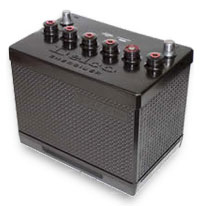
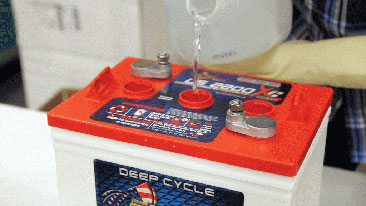
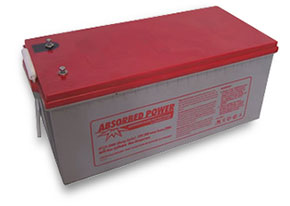
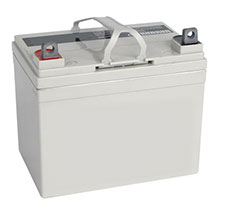
VRLA batteries remain under constant pressure of 1–4 psi. This pressure helps the recombination process during charging when more than 99% of the hydrogen and oxygen generated are turned back into water.
Unlike the flooded lead-acid battery, VRLA batteries are designed with a low overvoltage potential, which prohibits the battery from reaching its gas-generating potential during charge. This safeguard prevents excess charging, which would cause gassing and electrolyte depletion.
History of Lead-acid Batteries
Lead-acid is the oldest rechargeable battery technology in existence. Invented by the French physicist Gaston Planté in 1859, lead-acid was the first rechargeable battery to be used in commercial applications. More than one hundred fifty years later, we still have no real cost-effective alternatives for cars, boats, RVs, wheelchairs, scooters, golf carts, and UPS systems.
The lead-acid battery is still the most widely used 12 V energy storage device. A lead-acid battery is an electrical storage device that uses a chemical reaction to store and release energy. It uses a combination of lead plates and an electrolyte to convert electrical energy into potential chemical energy and back again.
There are many newer battery technologies available in the marketplace. However, lead-acid technologies are better understood and are widely accepted as the standard by which all other batteries are measured. Newer technologies often have operational constraints, including maximum and minimum operating temperatures and special charging requirements that make them less versatile and useful for the average consumer in everyday applications.
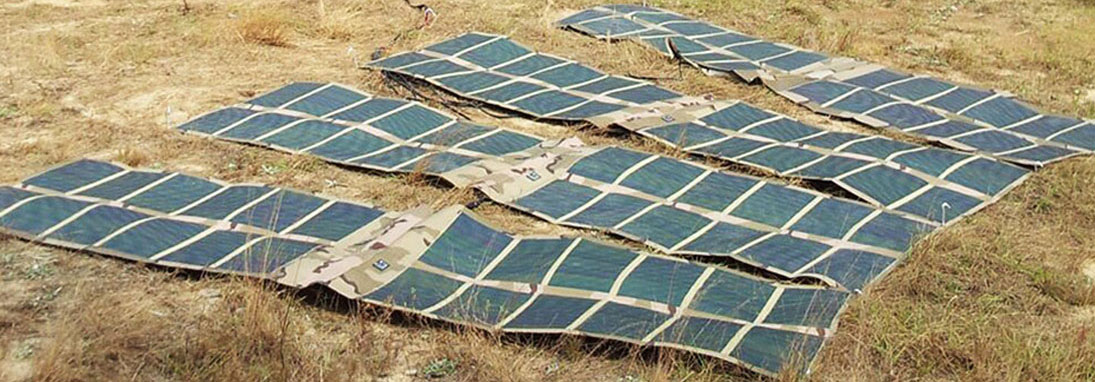
Flexible solar PV panels fuse form factor with capability and deliver maximum power generation with minimum weight. Flexible panels use amorphous silicon or copper indium gallium selenide (CIGS) thin-film technology, which can be used with many substrate options that allow flexible panels to be folded or rolled.
Solar Stik uses extremely rugged, paper-thin, flexible PV panels that can withstand harsh conditions.
As the name implies, thin-film solar PV cells lack the thickness of other PV technologies. Composed of a very thin layer of substance on a substrate, today’s thin-film cells are one percent as thick as the first manufactured silicon solar cells.
Foldable or rollable thin-film panels make storage and transport convenient. For low-power applications that require portability, thin-film solar PV panels are an excellent option.
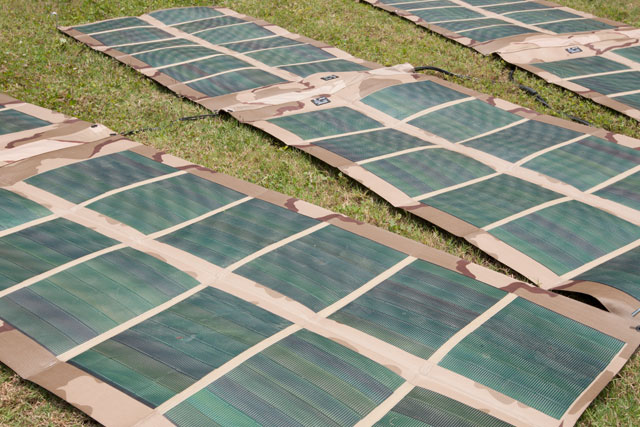
Numerous thin-film solar PV technologies exist today. However, they are slightly less efficient than other types of PV cells, so more surface area is required to generate the same amount of power. Most thin-film panels are designed for single-device applications, like recharging a battery-operated device.
The two most common types of thin-film solar PV panels are amorphous silicon and copper indium gallium selenide (CIGS).
![]()
Amorphous Silicon Solar PV Panel
Amorphous silicon is the oldest thin-film technology and arguably the best. When laid on a substrate, amorphous silicon does not require a grid configuration to conduct electricity, allowing it to be used on large areas with ease. However, it does not conduct as well as crystalline silicon solar PV cells used in rigid panel technology because the connections between the silicon atoms are not as consistent. This inconsistency results in interrupted electron flow.
Numerous substrate materials can be used with amorphous silicon, making the technology highly adaptable. Polymer plastic is one option for substrate. Because polymer plastic is flexible and able to be folded or rolled, it excels in applications requiring ease of storage or transport.
Amorphous silicon solar PV panels perform better in low light intensities. This makes amorphous silicon a good choice for environments with interrupted sunlight or dusty conditions.
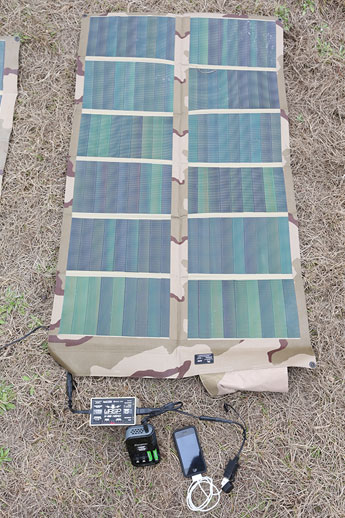
Copper, Indium, Gallium, Selenide (CIGS)
Copper, indium, gallium, and selenide comprise the photoelectric layer of a CIGS solar cell. The principles behind the operation of CIGS PV cells are the same as those for silicon cells, like those used in mono- and polycrystalline solar PV panels.
With CIGS cells, copper acts to receive electrons in a fashion similar to the positive layer (P-type silicon) of a silicon cell. Selenium provides extra electrons to act in the same way as the negative silicon layer (N-type silicon). These materials can be placed onto a variety of substrates, including thin flexible steel, glass, and polymers. Flexible steel is the most widely used because of its resistance to the high temperatures needed to lay the PV elements on the backing sheet.
CIGS panels have a higher-rated output per square foot of surface area than amorphous silicon panels, which allows for relatively smaller CIGS panel sizes to achieve an equal amount of power. However, CIGS panels occasionally require direct exposure to sunlight—a process known as “light soaking”—before they can be used after being stored in dark, hot conditions.
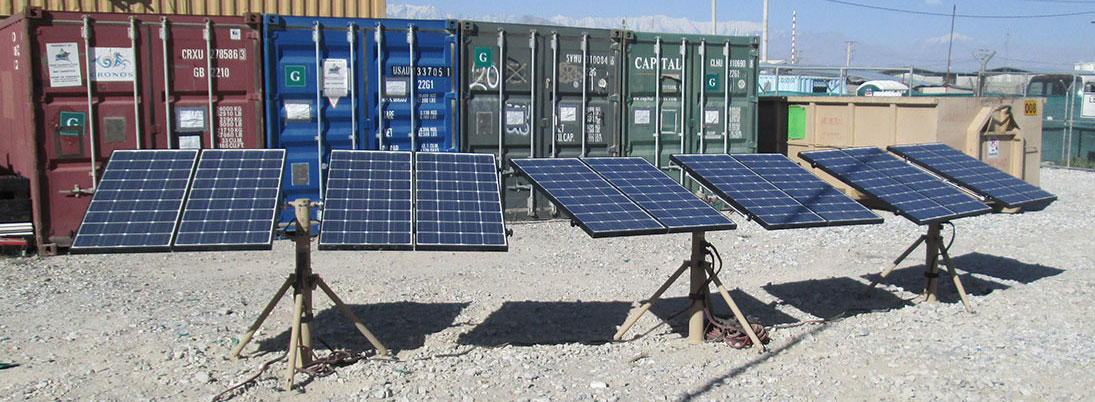
Rigid solar PV panels are ideal for stationary applications that require maximum power and a small installation footprint. They are the first generation of solar PV panels, provide more power per square foot than other PV panel types, and are highly durable. Rigid panels do not degrade significantly over time, making them a good choice for long-term investment.
Solar Stik uses both multi- and monocrystalline, glass and non-glass—impact-resistant and shatterproof—rigid panels.

Rigid solar PV panels are typically made of glass or non-glass panels and aluminum frames. Rigid panels are among the best performing panels, but their physical characteristics make them a poor choice for certain applications—especially when portable power is desired.
Travel and storage can be difficult because rigid panels often contain breakable glass and cannot be folded.
The Solar Stik system design overcomes many of the physical challenges associated with the rigid panels. This results in portable power systems that draw from the best available PV technology.
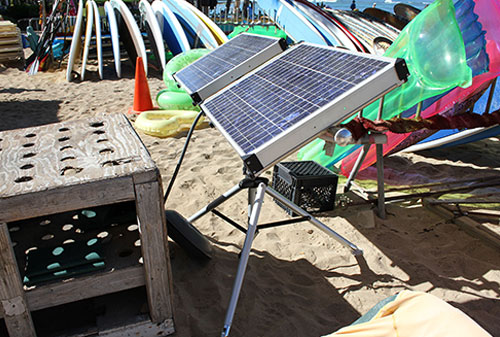
The two main types of rigid solar PV panels are monocrystalline and multi- or polycrystalline.
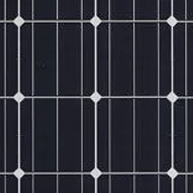
A rigid monocrystalline solar PV panel is distinctly recognizable by the arrangement of the individual solar PV cells (squares with no corners) that appears as a uniform, flat color.

The surface of a rigid multi- or polycrystalline solar PV panel has the appearance of a rectangular grid and more of a bluish speckled color.
Performance differences between rigid solar PV panels can be experienced in high operating temperatures and shaded conditions. Monocrystalline panels perform better in higher external temperatures and full sun. Multi- or polycrystalline panels suffer performance losses in higher heats but have slightly higher outputs compared to monocrystalline panels when the panel is partially shaded.
The role of the battery management system (BMS) is simple: It controls the actual voltage of each cell, so that it doesn’t get too high or too low.
2Prolong the life of the battery
3Maintain the battery in a state in which it can fulfill the functional requirements of the application
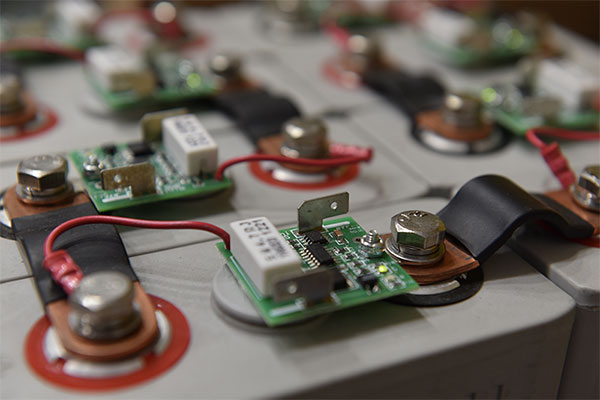
To achieve these objectives, the BMS may incorporate one or more of the following functions:
Cell Protection Protecting the battery from out of tolerance operating conditions is fundamental to all BMS applications. In practice the BMS must provide full cell protection to cover almost any eventuality. Operating a battery outside of its specified design limits will inevitably lead to failure of the battery. Apart from the inconvenience, the cost of replacing the battery can be prohibitive. This is particularly true for high voltage and high power automotive batteries which must operate in hostile environments and which at the same time are subject to abuse by the user.
Charge Control This is an essential feature of BMS. More batteries are damaged by inappropriate charging than by any other cause.
Demand Management While not directly related to the operation of the battery itself, demand management refers to the application in which the battery is used. Its objective is to minimize the current drain on the battery by designing power saving techniques into the application’s circuitry and thus prolong the time between battery charges.
State of Charge (SOC) Determination Many applications require a knowledge of the state of charge of the battery or of the individual cells in the battery chain. This may simply be for providing the user with an indication of the capacity left in the battery, or it could be needed in a control circuit to ensure optimum control of the charging process.
State of Health (SOH) Determination The state of health is a measure of a battery’s capability to deliver its specified output. This is vital for assessing the readiness of emergency power equipment and is an indicator of whether maintenance actions are needed.
Cell Balancing The many cells that constitute a battery can sometimes charge and discharge at different rates, depending on the cell temperature, age, and factors that occur during manufacture of the cells. Over time, these differences will become amplified if they are not corrected. It is important that while charging and discharging, the balance between all cells is maintained. If cells are out of balance, the entire battery pack is shut off when the weakest cell drops below the lower voltage limit, even if other cells are still not completely discharged. Cell balancers are usually placed throughout the cell circuit in order to maintain a balanced charge throughout the entire battery and thereby extending the life of the battery.
To minimize performance differences, BMS components called Protection Circuit Modules or Protection Circuit Boards (PCMs or PCBs) are connected to each cell. The PCBs constantly monitor and report critical parameters of each cell and make small adjustments to correct for any differences between cells. Balancing or equalizing all parameters of each cell in a battery is critical to ensure full life and capacity from a lithium battery.
History (Logbook Function) Monitoring and storing the battery’s history is another possible function of the BMS. This is needed in order to estimate the SOH of the battery, but also to determine whether it has been subject to abuse. Parameters such as number of cycles, maximum and minimum voltages and temperatures, and maximum charging and discharging currents can be recorded for subsequent evaluation. This can be an important tool in assessing warranty claims.
Authentication and Identification The BMS also allows the possibility to record information about the cell, such as the manufacturer’s type designation and the cell chemistry, which can facilitate automatic testing, and the batch or serial number and the date of manufacture, which enables traceability in case of cell failures.
Communications Most BMSs incorporate some form of communications between the battery and the charger or test equipment. Some have links to other systems interfacing with the battery for monitoring its condition or its history. Communications interfaces are also needed to allow the user access to the battery for modifying the BMS control parameters or for diagnostics and testing.
Bricking a LiFePO4 Battery
As soon as the BMS senses that the cell voltage is too low to discharge, time is of the essence to place the batteries on charge. Failure to do this may cause a fatal error known as “bricking”. Once the batteries reach their internal disconnect voltage, the voltage can fall very rapidly in the internal cells, causing the battery to brick. This means that the battery cells are nonrecoverable, and the battery module must be replaced.
Specific gravity of the electrolyte can be defined as:
A measure of the density of the liquid electrolyte compared to the density of water at a specific temperature and pressure.
The chemical reaction takes place inside the pores of the active material on the battery’s lead plates. If the battery has just been charged, the electrolyte in the pores of these lead plates is very rich in sulfuric acid. As a result, the battery’s voltage will be high, perhaps as much as 13 to 14 volts. As the battery rests following a charge, its voltage slowly drops and then levels off as the electrolyte stabilizes its chemical state between the plates.

“Zero Gravity” by Scott Robinson is licensed under CC BY 2.0
A similar change in battery voltage occurs during discharge. During the battery discharge process, the electrolyte transfers its sulfur content to the lead plates. As the electrolyte loses sulfur, its specific gravity gets “lighter” or closer to that of water, indicating that the battery has been discharged. Because the specific gravity of the electrolyte is measurable, it can be used to determine the state of a battery’s charge and health. While a fully charged battery may read 12.68 volts, the voltage will drop and then stabilize at a somewhat lower value as a load is applied.
The change in voltage occurs even though the state of charge of the battery has not significantly changed. This is due to the local electrolyte in the pores of the plates becoming less rich in sulfur as the battery supplies current. As the battery discharges, electrolyte more like sulfuric acid enters the pores while electrolyte more like water exits the pores.
As discharge continues, the electrolyte in the pores eventually stabilizes at a specific gravity somewhat lower than the average value in the battery, producing the slightly lower battery voltage.
The operational characteristics of the lead-acid battery can be explained best by the terms capacity and cold-cranking amps (CCA).
Capacity is the amount of energy a battery can store. It is usually given in amp hours (Ah), or the amount of current measured in amps that the battery can provide over a period of one hour before rendering the battery discharged.
The secret of any battery’s runtime lies in the battery’s plate capacity. During charging and discharging, the lead on the plates gets gradually eaten away and the sediment falls to the bottom. The service life of a lead-acid battery can be measured by the thickness of the positive plates. The thicker the plates, the longer the life will be and the more energy storage you can expect.
The weight of a battery is another good indicator of the lead content and the life expectancy. Generally speaking, the heavier the battery, the more lead it contains and the longer it will last.
Most industrial flooded deep-cycle batteries use lead-antimony plates. Antimony is a metal that stiffens the lead plate and helps prevent battery failure due to structural failure of a plate. This improves the plate’s life but increases gassing and water loss. Antimony is not necessary in AGM batteries due to the rigid construction of the overall battery.
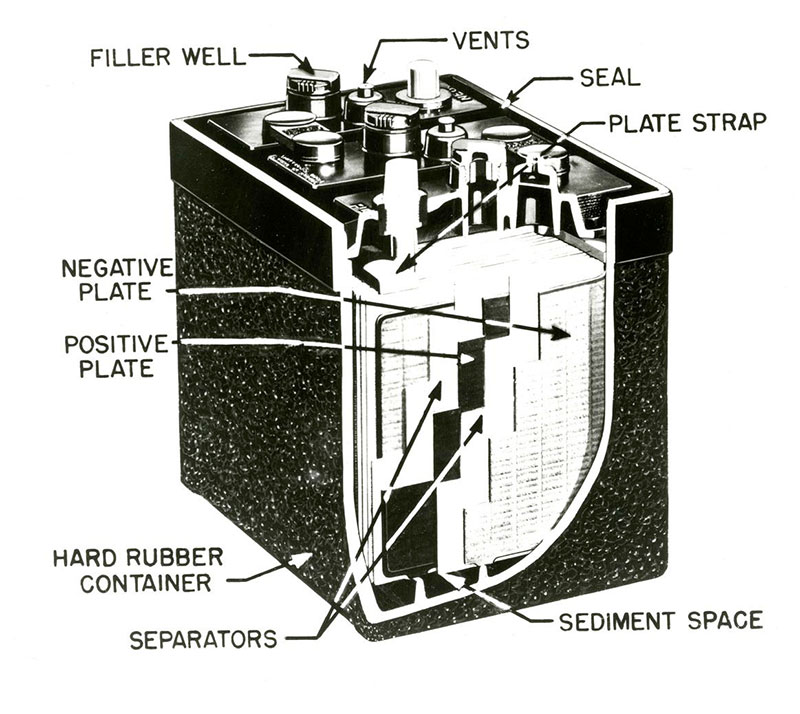
1953 automotive lead-acid battery

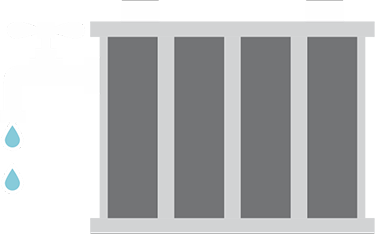
Cold-cranking amps (CCA) is the amount of energy a battery can deliver in short bursts. It is the maximum amount of current (amps) that a battery can deliver at 0 °F for 30 seconds without dropping below 7.2 volts. A high CCA battery rating is good, especially in cold weather. Starter batteries are often rated in CCA and are designed to deliver a short-duration burst of power, such as that required to start a vehicle.
Age and environmental conditions can affect the capacity and the CCA. As a battery ages, capacity and CCA will not degrade at the same rate. CCA tends to stay high through most of the battery’s life, but it drops quickly towards the end. If you drive a car, you’ve probably experienced this when, near the end of the battery’s life, suddenly the battery won’t start the car in the morning.


Capacity decreases gradually. A new battery is designed to deliver 100% of its rated capacity. As the battery ages, the capacity steadily drops and it should be replaced when its ability to store power falls below 70% of its original rating.
The overall health of a battery is most directly related to its capacity, not its CCA. As noted before, the CCA remains within the optimal range for most of a battery’s life, so performance and health declines will be most notable in the loss of capacity.
The illustration shows two fully charged lead-acid batteries, one with a high capacity and one that has aged. The buildup of visible “rock content” (crystalline formation, also called sulfation or memory) due to aging robs the battery of usable capacity, although the battery may still provide good cranking power.
Appliance efficiency is also known as load efficiency. As appliances consume less power, power source requirements also change. When designing a portable power system, purchasing highly efficient components can provide many benefits.
Appliance loads can often be matched to the electrical characteristics of the circuit. This will increase the system’s overall efficiency by allowing direct connection to the circuit without the need for additional power management devices to aid in the function.
The fewer management components used in a system, the more efficiently it will operate. For example, components such as inverters, converters, or similar devices used in a circuit to “adapt” appliances for use in a particular electrical circuit themselves require power to operate, and thus the total power required to operate the appliance is increased.
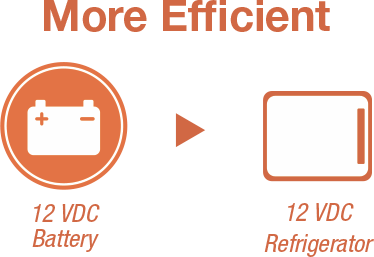
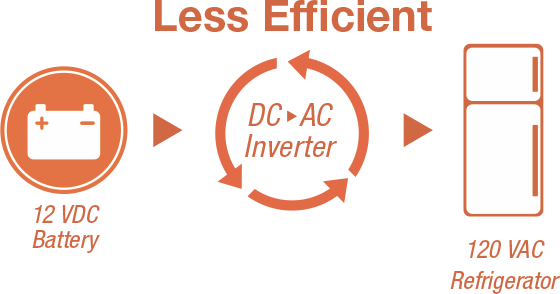
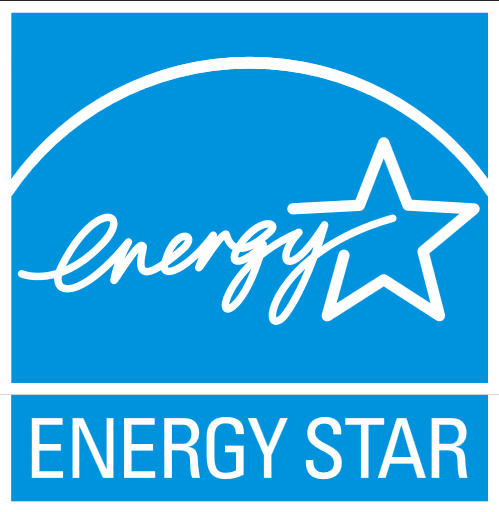
For example, a 12-volt direct current (DC) electrical circuit powered by a 12 V battery can directly support a refrigerator that also operates at 12 VDC. This setup will transfer power through the circuit more efficiently than if the refrigerator requires 120 V alternating current (AC) power. In the latter example, an inverter would be required.
It is prudent to shop around when looking for appliances because power consumption varies among models even within a particular appliance class. Purchasing an energy-efficient device can be more expensive up front, but could mean future savings in energy costs as well as a flexibility of use that makes the device compatible with a variety of portable power sources. When purchasing an electrical appliance, remember to ask if a 12 VDC adapter is available for the product.
A pure sine (also referred to as a sinusoidal) wave can be produced by rotating machinery (a generator). This is the type of waveform provided by electric utility companies. This type of power is available anywhere an outlet is tied to the power grid, such as in homes or businesses.
A PSW inverter reproduces this waveform through the use of advanced internal circuitry.
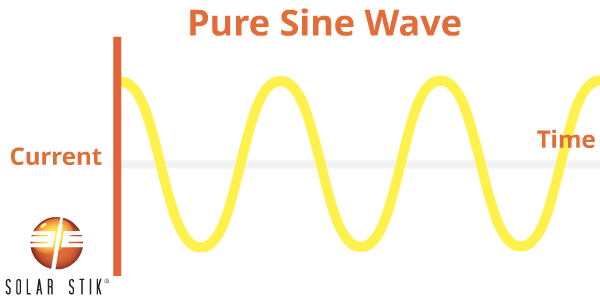
A modified sine wave (also referred to as non-sinusoidal or step-wave) inverter is different from a pure sine wave power inverter because the modified waveform output is step-shaped.
AC appliances that are not specifically designed to work with this type of inverter waveform output may take more power to operate, thereby reducing the efficiency of the entire electrical system. For example, some appliance motors may produce more heat and burn out when they are operating.
Other appliances that use electronic controls will not be able to vary speed or temperature when using modified sine wave power. Some fluorescent lighting may not get as bright or may make buzzing noises. Appliances with digital clocks or electronic timers may not work properly with this type of inverter because the waves are rougher and cause extra noise to be created in the circuitry.
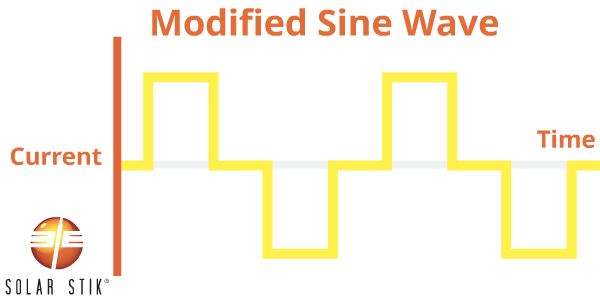
The following appliances may experience problems when operated from MSW inverters:
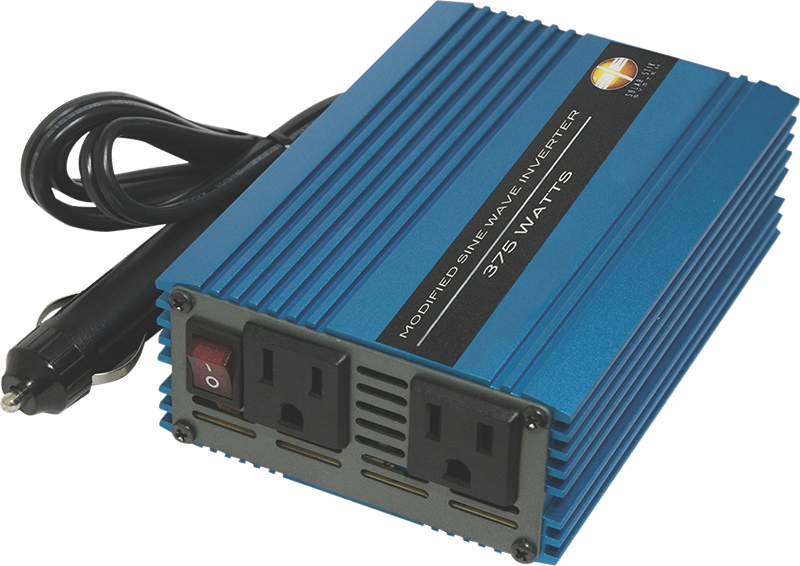
Low-wattage Inverters
Most vehicle starting batteries will support a low-wattage inverter for short time periods. Actual operating time will vary depending on the age and condition of the battery, the Ah capacity of the battery, and the AC appliance powered by the inverter. If you use a low-wattage inverter that is powered through a DC accessory socket, and the vehicle engine is turned off, you should periodically run the engine to recharge the battery.
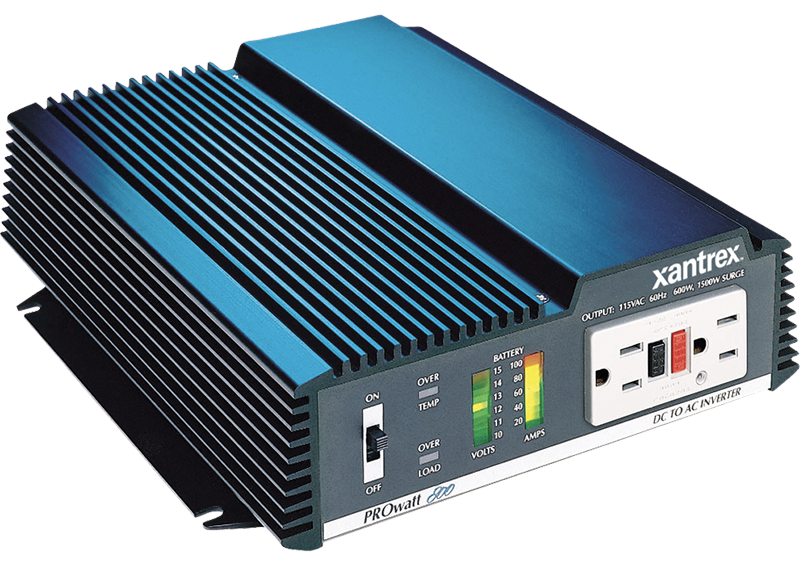
Medium- and High-wattage Inverters
It is strongly recommended that only deep-cycle batteries be used for any inverter with a continuous output of 200 W or more. This will ensure that you have several hundred complete charge and discharge cycles. If you use a normal vehicle starting battery to support a medium- or high-wattage inverter, it will quickly fail after repeated charge/discharge cycles (since starting batteries are not designed to perform this type of work).
When the inverter operates power-hungry appliances with continuous loads for extended periods, it will drain the battery to the point where the battery has insufficient energy to support the inverter. In these cases, it’s a good idea to have additional deep-cycle batteries available to extend the appliance operating time.
Lead-acid batteries are the most commonly used batteries and come in several different configurations. The oldest of the lead-acid battery types are flooded-cell (or wet-cell) batteries and can be either the sealed or the open variety. In both types, the electrolyte evaporates due to charging, age, or ambient heat.
In the mid 1970s, a “maintenance-free” valve-regulated lead-acid (VRLA) battery was developed.
VRLA batteries can be absorbed glass mat (AGM) or gel cells. Solar Stik uses AGM batteries in its lead-acid products.
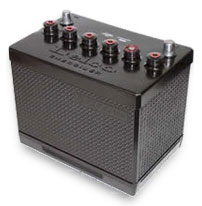
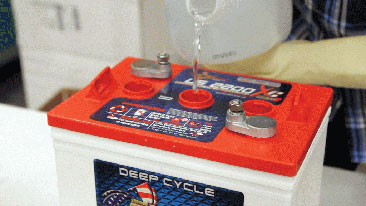
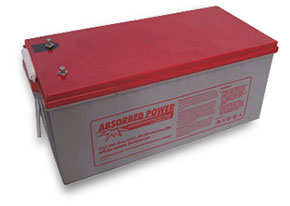
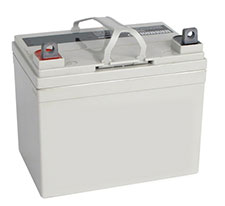
VRLA batteries remain under constant pressure of 1–4 psi. This pressure helps the recombination process during charging when more than 99% of the hydrogen and oxygen generated are turned back into water.
Unlike the flooded lead-acid battery, VRLA batteries are designed with a low overvoltage potential, which prohibits the battery from reaching its gas-generating potential during charge. This safeguard prevents excess charging, which would cause gassing and electrolyte depletion.
History of Lead-acid Batteries
Lead-acid is the oldest rechargeable battery technology in existence. Invented by the French physicist Gaston Planté in 1859, lead-acid was the first rechargeable battery to be used in commercial applications. More than one hundred fifty years later, we still have no real cost-effective alternatives for cars, boats, RVs, wheelchairs, scooters, golf carts, and UPS systems.
The lead-acid battery is still the most widely used 12 V energy storage device. A lead-acid battery is an electrical storage device that uses a chemical reaction to store and release energy. It uses a combination of lead plates and an electrolyte to convert electrical energy into potential chemical energy and back again.
There are many newer battery technologies available in the marketplace. However, lead-acid technologies are better understood and are widely accepted as the standard by which all other batteries are measured. Newer technologies often have operational constraints, including maximum and minimum operating temperatures and special charging requirements that make them less versatile and useful for the average consumer in everyday applications.
Lead-acid batteries are commonly made of five basic components:
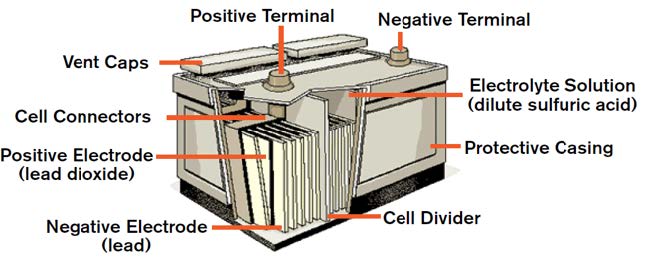
A battery cell is a container in which electrolyte and lead plates can interact. The electrolyte is usually a solution made up of 35% sulfuric acid and 65% water. The lead plates are treated with lead oxide and powdered sulfates to give them their positive and negative properties.
When the positive and negative lead plates are submerged in the battery’s electrolyte, a chemical reaction occurs. This reaction causes electrons to flow between the lead plates. The negative lead plate builds up an excess of electrons in a process called oxidation. This causes an electrical difference between the negative plate and positive plate.
The extra electrons on the negative lead plate want to displace the electrons on the positive plate in a process called reduction. However, the electrolyte solution of sulfuric acid and water ensures the electrons cannot travel directly to the positive plate. When the circuit is closed (with the help of a “conductive path”, or load, between the negative and positive plates), the electrons are able to travel to the positive plate. This, in turn, provides power to any appliance placed along the path.
This electrochemical process can be summarized as a reversible transfer of sulfate between the water and the lead plates during charging and discharging. As the battery is discharged, sulfate in the solution combines chemically with the lead plates of the battery to form lead sulfate. As the plates accumulate this sulfate, the electrolyte solution becomes more like water and less like sulfuric acid. The reverse occurs as the battery is charged. As charging current flows into the battery, the battery plates revert back to their original condition and the electrolyte reverts back to its original sulfuric acid content.
Lithium-ion batteries are made of the following basic components:
The exact chemistry is often patented and proprietary to each battery maker.
When a charge is applied to a lithium-ion battery, electrons flow between the internal components. The basis of this reaction is the lithium metal binding and unbinding with the other chemicals in the electrodes at the ionic level. As power is drawn out of the battery, the metal moves from one electrode to the other, and when the battery is charged, it moves back to the original state. The metallic lithium ions literally move through the separator material.